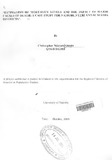| dc.description.abstract | Demographic surveys and population censuses only give the number of deaths without
indicating the causes and this limits the usefulness of the data in designing health policies
and programmes. Under the civil registration system, not all events are registered in some
of the districts in the country. It has therefore become necessary to evaluate death
registration data and estimate mortality levelS-Eased on the adjusted data.
This study set out to estimate completeness of death registration; estimate mortality
levels; generate life tables and compare the results with the census results for Nairobi,
)
Nyeri and Bungoma districts. The study also set out to estimate the effects of
hypothetically eliminating single causes of death on life expectancy. The study applies
the Brass Growth Balance method and the Bennett-Horiuchi method. The data used in the
study are the 1989 and 1999 population census data and the death registration data
captured for the year 1999.
The Brass Growth Balance method estimates completeness of death registration to be 55,
127 and 105 percent among males and 138, 94 and 76 percent among females in Nairobi,
.- Nyeri and Bungoma respectively. The Bennett-Horiuchi method estimates death
registration completeness as 61, 56 and 122 percent among males and 130, 42 and 95
percent among femal~ Nairobi, Nyeri and Bungoma respectively. The degree of
completeness from the two methods are comparable for the Nairobi and Bungoma data
but markedly different in respect of the Nyeri data. Both methods generates the
completeness of death registration that are too low for males in Nairobi whereas the
Bennett-Horiuchi method grossly underestimates the completeness for both sexes in
Nyeri district. Overall, the Brass Growth Balance method underestimates the life
expectancies whereas the Bennett-Horiuchi method overestimates the life expectancies at
most ages as compared to the census results. Since different estimation procedures are
sensitive to a variety of possible sources of distortions on data in different ways, it is
important that different methodologies are applied in estimation procedures to serve as
consistency checks on the results obtained.
For the Kenya to discard its reliance on indirect methods of estimation and rely more on
the direct methods of estimation, the coverage and quality '------ of the data generated from the
censuses and registration systems must be improved. This therefore calls for a holistic
approach to addressing the issues that affect quality of data in this country. Apart from
allocating more resources to the relevant departments, the populations' levels of
education and standards of living must be improved. | en |

